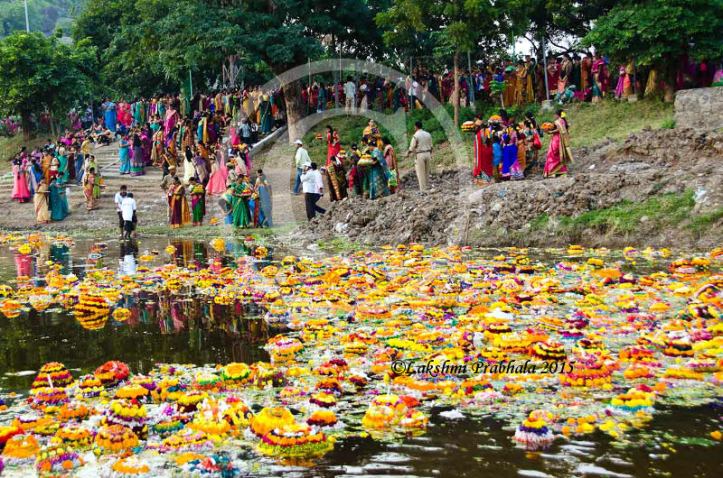Among the numerous festivals in India, only a few possess a strong regional influence and contribute to a cultural identity. Bathukamma Panduga is one such festival specific to the Telangana State. Celebrated annually by women during Navarathri, as a tribute to the Goddess Gauri, also referred to as Bathukamma, and seek Her blessings for prosperity. [“Bathuku” meaning life, “amma” means mother alluding to the Goddess].
Bathukamma is now a state festival of Telangana and celebrated with great pomp and fervor across the state. In Hyderabad, the celebrations now entail processions of folk artistes and a group of 20,000 women accompanied by balloons, sky lanterns and fireworks, I was more keen on witnessing an ethnic version of the festival.
We made a quick impromptu plan and headed to Warangal. After a quick lunch, we hung around at the Thousand pillar temple, trying to figure out the best place to check out the Bathukamma festival. The landscape in and around Warangal is filled with many rock formations and lakes in their vicinity. While Bhadrakali temple came highly recommended, a lady suggested we go to Padmakshigutta. “If you go there, you will never feel like coming back”, she exclaimed enthusiastically in typical Telangana dialect. We took her suggestion and found ourselves at the venue. As we approached the Padmakshigutta, we saw women dressed in all grandeur, heading towards the temple, holding the beautiful Bathukammas of various sizes in their hands.
Bathukamma essentially, is a stack of seasonal flowers, beautifully arranged in concentric layers on a conical mound. On the top, a cone made of turmeric or the gynoecium of a pumpkin flower is placed and together this floral arrangement is worshipped as Goddess Batukamma. The wooden base used for making the Bathukamma is called ‘taambaalam’.

There are many legends surrounding the origin of the festival. One story talks of the Goddess Gauri setting herself on fire due to humiliation of her husband Lord Shiva at the hands of Her father at the great yagna(sacrifice). In a hope to bring Her back, all the women present make a turmeric idol of the Goddess worship it with plenty of flowers and sing and dance around the idol. Another tale is about King Dharmangada of Chola Dynasty who ruled South India. His wife gave birth to Princess Lakshmi after many prayers and rituals. The child survived many accidents and mishaps and hence, the parents named her Batukamma.
The women gather in large circles around the Bathukamma placed in the centre, singing songs in chorus going around it in circles, synchronising steps and claps – thereby creating circle of unity and sisterhood. As the rhythms of the folk songs echo in the streets, the tales of the common woman, her dreams as well as difficulties, and the socio-economic and political conditions of the region lend a unique Telangana flavour to the festival.


After dancing around the Batukammas in their neighbouhood, the women folk go as a procession towards a bigger lake or pond, carrying them on their heads, singing songs along the way. Finally when they reach the lake the “Batukammalu” are slowly set afloat into the water. The women then exchange haldi and kumkum as it is considered auspicious and share sweets. Maleeda is a sweet made specially for this festival, from sugar/jaggery and flour. The procession as well as the number of floral mounds floating in water is a visual treat

While colours, flowers and water are all characteristic to most Indian festivals; what makes Bathukamma unique is that the Goddess is not constrained only to a temple but made of flowers that indicate dual aspects of life- continuity as well as transience. This festival is akin to Thanksgiving to the Mother of life and the bountiful nature. It is a celebration of the season of blooming flowers, of overflowing water ponds, and harmonious relationship between human beings and Mother Nature.
It was difficult to leave the place with the festivity picking up every minute as more groups of women joined in. On our way back from Warangal the same night, many towns and villages echoed of the Bathukamma songs and lakes were filled to the brim with Bathukammas.
Its is like giving the water a gift of love from us. It is a festival of nature and humans
Absolutely. To celebrate the harmony between humans and Mother Nature!